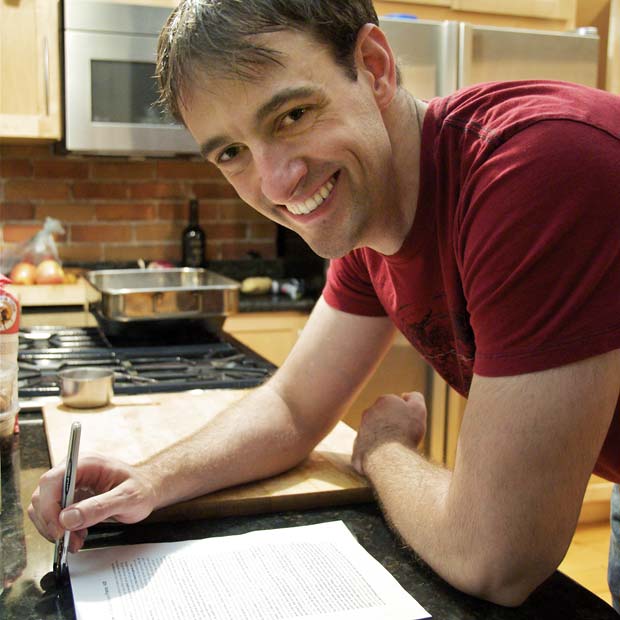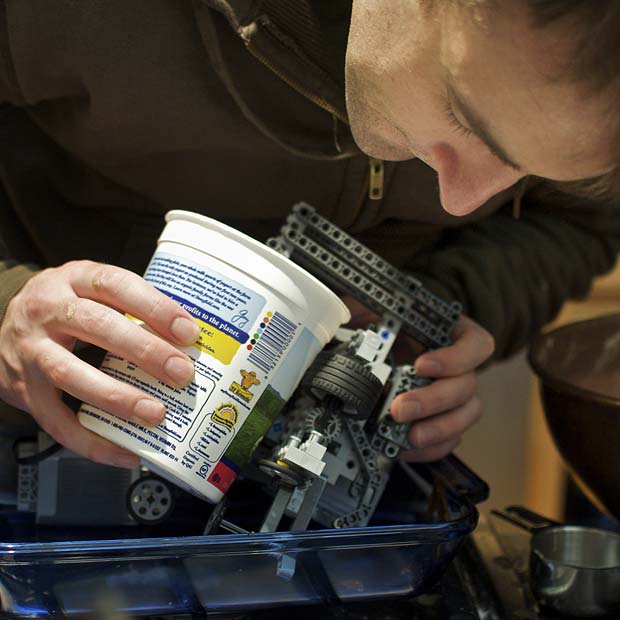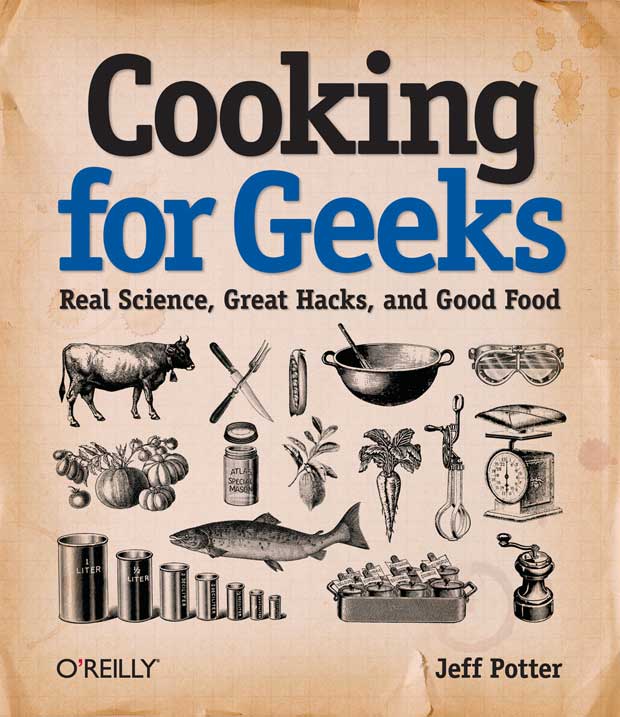
Jeff working on a recipe in his kitchen. (Photo by Shimon Rura. © 2009 Atof Inc.)
For a book about food this is a rather unusual book. The author states in the preface that the goal of the book is to “point out new ways of thinking about the tools” that are found in the kitchen. It’s not a book you’ll pick up for its recipes, even though the 100+ recipes included are fine. And it’s not a book you would pick up because of mouthwatering photographs of food. It is however a book that could trigger a lifelong interest in cooking among those who are scientifically minded. Where an experienced chef can read between the lines of a recipe, the rest of us can turn to books like Cooking for geeks to get hints on how to turn a recipe into a tasty dish.
The book is filled with advice ranging from the obvious (when straining pasta, pour the boiling water away from you) to the interesting and brilliant, such as the best way of cracking an egg. My experience from working in a shared lab is that you can learn a lot from observing how your colleagues work in the lab. A kitchen is not too different from a lab, and Potter has done a good job capturing small, trivial and “obvious” details, the tricks of the trade. For an inexperienced cook the obvious is often the best place to start, and it’s a good thing the author dares to include this kind of advice.
Following tips on kitchen tools and gadgets, how to pick a recipe, how to organize the kitchen and how to calibrate equipment, the book focuses on the basics of flavor. But where many science books leave it with descriptive text about taste and smell, Potter goes on to propose experiments to try out in the kitchen. And the systematic and analytical mind of the authors shines through when he lists typical bitter, salty, sour, sweet, umami and hot ingredients from different regional cuisines.
The chapter which may have the greatest potential of improving your cooking, covers time, temperature and cooking methods. Depending on the meat used the denaturation of proteins occurs at different temperatures. That’s why it’s important to know at which temperature you cook. Combine this with different methods of heat transfer (conduction, convection, radiation) and varying rates of heat transfer in foods, and you’re left with a complex set of equations to solve in order to obtain a steak with a nicely browned surface, an outer layer which is not overcooked and a core with the desired doneness. Luckily there are easy ways to achieve this, and the book includes an introduction to sous vide cooking and the hardware needed for this. Using temperature controlled water baths (not unlike the ones used in chemistry labs), meat is sealed in plastic bags and cooked at the desired core temperature, thereby avoiding heat gradients all together. For better flavor, a quick browning is recommended to get the Maillard reaction going.
The chapter “Playing with chemicals” may frighten the average consumer, but certainly warms the heart of chemist who is well aware of the many pure chemicals and polymers found in the kitchen. Sugar, salt, acids and bases are well known, hydrocolloids perhaps less so. But they are even more fun to play around with. Ranging from well known starch and gelatin to more exotic gelling agents such as agar, carrageenan and sodium alginate to mention a few, Potter explains the science and gives practical tips on how to succeed with the recipes.
In between the many fact boxes, recipes and tables there are also more than 20 interviews with scientists, food professionals, and bloggers to be found. Again, not very common for a cook book, but it fits in nicely with all the other bits of information. At this point I should also mention (in the interest of full disclosure) that as a food blogger I was one of the lucky persons to be interviewed for the book.

Jeff working on an ice cream maker made with Legos. (Photo © 2009 Atof Inc.)
Jeff Potter is a computer scientist and makes no attempt at hiding this in the book, for instance when he wants to overclock an oven to make a perfect pizza. The book is strewn with “hacker lingo”, and what some may term a good sense of humor others frown at as geeky jokes and unnecessary references to software engineering. In my opinion the book could have reached an even greater audience without the references to computer science. Apart from this my main objection against the book is the lack of color photos, and the minuscule size of the b/w photos. Some of the pictures are available in color and high resolution through flickr.com though, and the author also encourages users to post pictures tagged with “cookingforgeeks” at the same site.
Despite these objections it is a well researched book, and the wide range of topics and the number of fun facts, hacks and tips is amazing. Jeff Potter succeeds in bringing popular food science to a broad audience, and I’m convinced that the book could even find its place in science education and as a source of inspiration for science projects. The book also encourages a work methodology that is familiar to every chemists: experiment and observation. This is obvious in the lab, but just as useful in the kitchen. And in case you’re still curious about the eggs: Crack them on a flat surface. This will result in larger pieces that aren’t pushed into the egg. Since I read this tip I’ve tried it several times, and it works very well!
Review by Martin Lersch
Based in Norway, organic chemist Martin Lersch blogs about food and chemistry at Khymos (blog.khymos.org) besides his day time work in R&D at a biorefinery.
Copyright Nature Chemistry. This review was first published in Nature Chemistry as “Kitchen hacks for better cooking” (Lersch, M. Nature Chemistry 2010, 1001. DOI: 10.1038/nchem.879).
Cooking for Geeks
by Jeff Potter
O’REILLY MEDIA: 2010.
432 pp. $34.99


I say, Nature Chemistry 🙂 Cool. Congratulations!
And, BTW: thanks for the tip
Hei
Veldig fin side. Jeg er kokk selv og har eksperimentert litt med molykulær gastronomi. Var nettopp å spiste hos Thomas Keller. Fasinerende. Veldig fin side. Har du noen fåredrag i Bergen i den kommende tiden?
Sjekk ut siden min
http://matlidenskap.com
Skal faktisk ha foredrag på VilVite senteret i Bergen 17. november 🙂
Count me in.. Har en kollega fra Feinschmecker som har snakket varmt om det du hadde her i fjor. Gleder meg allerede…
The egg tip comes directly from Jaques Pepin, you can read about it in Complete Techniques, highly recommended reference book.
Besides easier, he claims that it is also safer, as contaminated outer egg is less likely to touch the inner egg. This was probably more of an issue when he was working in his mother’s restaurant 70 years ago.
Well done with Nature Chemistry.
Michael: Thanks for the comment. Interestingly I just saw Jaques Pepin’s book mentioned on another blog on food written by a Chemist – the relatively new “The ungraduated cylinder”. I don’t have Pepin’s book, but I should clearly add it to my wish list!